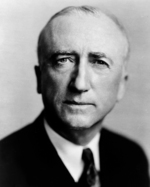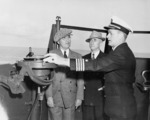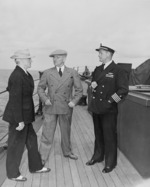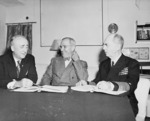James Byrnes
| Surname | Byrnes |
| Given Name | James |
| Born | 2 May 1882 |
| Died | 9 Apr 1972 |
| Country | United States |
| Category | Government |
| Gender | Male |
Contributor: C. Peter Chen
ww2dbaseJames Francis "Jimmy" Byrnes was born in Charleston, South Carolina, United States in 1882 to the senior James Byrnes and Elizabeth McSweeney Byrnes, a dressmaker. His father passed away shortly after his birth. He became interested in law through his cousin Frank J. Hogan, who was an attorney. In 1896, he left school to work in a law office, later becoming a court stenographer. In 1906, he married Maude Perkins Busch. In 1900, Governor Miles B. McSweeney, a cousin, appointed him as a clerk for Judge Robert Aldrich; that position required the candidate to be of 21 years of age, and McSweeney circumvented this restriction by allowing Byrnes to use his older sister Leonora's birth date. In 1903, he was admitted into the bar. Between 1908 and 1910, he was the solicitor for the second circuit of South Carolina. Between 1911 and 1925, he was a member of the US House of Representatives. In 1924, he sought a seat in the US Senate, but failed. Returning to private life, he established his own law practice, and growing his wealth under the guidance of his friend Bernard Baruch. In 1930, he successful won a seat in the US Senate. As a Senator, his domestic accomplishments included the successful Santee Cooper hydroelectric utility project, and his infamous decisions against anti-lynching laws (he went as far as saying that lynchings were necessary "in order to hold in check the Negro in the south"). On national and international issues, he generally aligned himself with Franklin Roosevelt. As Europe plunged into war, he became a strong supporter of Roosevelt's pro-British sentiments. Later, he supported Roosevelt in placing heavy trade and diplomatic pressures on Japan. In Jul 1941, he was appointed Associate Justice of the Supreme Court by Roosevelt.
ww2dbaseAfter the US entry into WW2, Byrnes left the Department of Justice in Oct 1942 to serve as the head the Office of Economic Stabilization, one of many new offices created by Roosevelt to manage the war time economy. In May 1943, he was made the head of the Office of War Mobilization, a newly created office that managed the Office of Economic Stabilization. It was around this time that many nicknamed him the "Assistant President", but his actual chance of becoming Roosevelt's vice president in the 1944 election was slim, as Democratic Party officials thought Byrnes was too conservative to win organized labor votes and too racist to win Black votes; Senator Harry Truman would ultimately be chosen as Roosevelt's running mate. He accompanied Roosevelt at the Yalta Conference in early 1945, and his detailed notes represented the most complete records of this meeting. After Roosevelt's death, President Truman relied heavily on Byrnes' counsel. In Jul 1945, Truman made him the Secretary of State despite the fact that Byrnes did not have extensive experience in foreign affairs; it was possible that Truman valued Byrnes as an attendee of the Yalta Conference. In that role, he attended the Potsdam Conference and the Paris Peace Conference. Friction began to grow between Truman and Byrnes within months of Byrnes' appointment, particularly because of Truman's dislike of Byrnes' independent streak, making foreign policy decisions without consultation with the president; at times, Truman was not even informed. "I had been left in the dark about the Moscow conference", Truman told Byrnes bluntly after the Dec 1945 meeting, for example. This ultimately led to Byrnes' resignation in 1947.
ww2dbaseByrnes was elected the governor of his home state of South Carolina in 1951. In this role, he supported the segregation of White Americans and Black Americans in education while, with a slight change of heart when compared to his younger self, fought hard to secure funding for Black schools. He also sought to curb the power of the Ku Klux Klan, a violent racist organization, by passing a law that prohibited adults from wearing a mask in public on any day other than Halloween. In 1954, after the US Supreme Court announced its decision in "Brown v. Board of Education of Topeka" (ie. declaring the segregation of schools by race as unconstitutional), he voiced opposition, noting that his "separate but equal" approach was more attainable than a complete integration. He announced his retirement as governor in 1954, and he stepped down in Jan 1955 at the end of his term. He remained an influential political figure for many years to come, though not necessarily in support of fellow Democratic Party members as he perceived that the ideals of the party had changed since his joining. He passed away in 1972 and was buried at the Trinity Episcopal Church in Columbia, South Carolina. His wife would pass away in Jul 1976.
ww2dbaseSource: Wikipedia
Last Major Revision: Jan 2019
James Byrnes Interactive Map
Photographs
 |  |  |  |
Videos
 |
James Byrnes Timeline
| 2 May 1882 | James Byrnes was born in Charleston, South Carolina, United States. |
| 4 Mar 1911 | James Byrnes became a member of the US House of Representatives. |
| 3 Mar 1925 | James Byrnes stepped down as a member of the US House of Representatives. |
| 4 Mar 1931 | James Byrnes became a member of the US Senate. |
| 25 Jun 1941 | James Byrnes was made an Associate Justice of the Supreme Court of the United States. |
| 8 Jul 1941 | James Byrnes steppe down as a member of the US Senate. |
| 3 Oct 1942 | James Byrnes stepped down as an Associate Justice of the Supreme Court of the United States and was made the Director of the Office of Economic Stabilization. |
| 27 May 1943 | James Byrnes stepped down as the Director of the Office of Economic Stabilization and was made the Director of the Office of War Mobilization. |
| 3 Jul 1945 | James Byrnes stepped down as the Director of the Office of War Mobilization and was made the US Secretary of State, succeeding Edward Stettinius, Jr. |
| 11 Aug 1945 | US Secretary of State James Byrnes rejected the Japanese surrender terms offered on the previous day, citing the refusal for any Japanese preconditions. Meanwhile, American aircraft continued conventional bombing of Japanese cities. |
| 11 Aug 1945 | US Secretary of State James Byrnes ordered Ambassador W. Averell Harriman in Moscow, Russia to prevent the inclusion of the Inner Mongolia region of China in the borders of an independent Mongolia. The indpendence of the Soviet puppet state of Mongolian People's Republic from China was an issue Joseph Stalin was aiming to achieve in the Sino-Soviet Friendship Treaty which was in the process of being drafted. |
| 19 Aug 1945 | US Secretary of State James Byrnes declared that Thailand was "not an enemy but as a country to be liberated from the enemy", in response to Regent Pridi Phanomyong's declaration that Thailand's participation in WW2 was unconstitutional. |
| 21 Jan 1947 | James Byrnes resigned as the US Secretary of State. |
| 16 Jan 1951 | James Byrnes became the Governor of South Carolina, United States. |
| 18 Jan 1955 | James Byrnes stepped down as the Governor of South Carolina, United States. |
| 9 Apr 1972 | James Byrnes passed away in Columbia, South Carolina, United States. |
Please consider supporting us on Patreon. Even $1 per month will go a long way! Thank you. Please help us spread the word: Stay updated with WW2DB: |

» Yalta Conference
» Potsdam Conference
- » 1,181 biographies
- » 337 events
- » 45,132 timeline entries
- » 1,249 ships
- » 350 aircraft models
- » 207 vehicle models
- » 376 weapon models
- » 123 historical documents
- » 261 facilities
- » 470 book reviews
- » 28,426 photos
- » 365 maps
James Forrestal, Secretary of the Navy, 23 Feb 1945
Please consider supporting us on Patreon. Even $1 a month will go a long way. Thank you!
Or, please support us by purchasing some WW2DB merchandise at TeeSpring, Thank you!